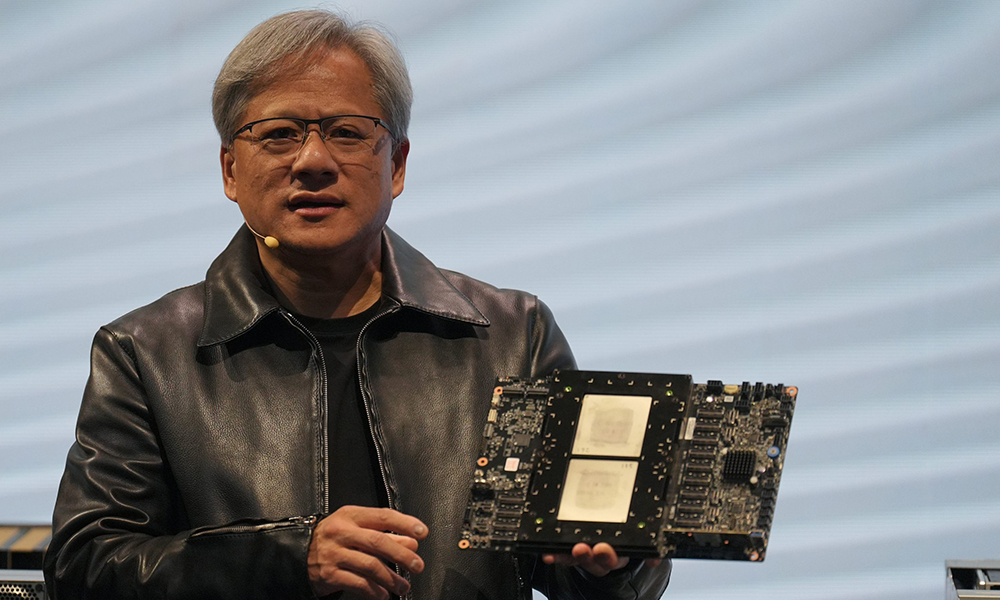
上周,半导体巨头英伟达成为全球市值最高的公司,这要归功于该公司多年前采取的明智举措,这些举措为其垄断人工智能芯片市场奠定了基础。
早在登上企业界顶峰之前,英伟达还是一家崭露头角的初创公司,最初是由首席执行官黄仁勋与联合创始人克里斯·马拉科夫斯基和柯蒂斯·普里姆在丹尼连锁餐厅(Denny’s)的一个分隔用餐区构想出来的。该公司于1993年成立后不久,就发明了首批图形处理器(GPU),最初用于视频游戏和图形设计。
从那时起,这家公司雄心勃勃,并逐渐发展壮大,以至于一举成名。该公司的名称是拉丁语"嫉妒”一词的双关语,并以3.34万亿美元的市值令苹果(Apple)、微软(Microsoft)和谷歌(Google)等科技巨头望尘莫及(自今年1月以来,该公司的市值已增长了一倍多)。但它是如何达到巅峰的呢?分析师告诉《财富》杂志,该公司取得成功的关键在于,早在几十年前就为如今席卷市场的人工智能热潮做好了准备。
中央处理器(CPU)是最常见的计算机芯片,可追溯到20世纪50年代,非常适合一次执行一个复杂的计算,但当深度学习和人工智能研究在2010年代得到迅猛发展时,中央处理器就无法满足数据科学家的需求了。相比之下,英伟达的图形处理器更能满足人工智能的需求,原因是它们可以一次执行许多简单的计算。早在2012年,OpenAI的前首席科学家、人工智能初创公司Safe Superintelligence的联合创始人伊尔亚·苏茨克维(Ilya Sutskever)就已经在使用英伟达的芯片开发名为AlexNet的早期卷积神经网络。
英伟达的芯片近年来发展迅速,去年8月发布的GH200 Grace Hopper超级芯片如今每秒可以执行200百亿亿次(200后面跟着18个零)计算。
贝雅(Baird)半导体高级研究分析师特里斯坦·杰拉(Tristan Gerra)对《财富》杂志表示,英伟达之所以能够垄断人工智能市场,完全要归功于首席执行官黄仁勋多年前的及时押注。黄仁勋的先见之明之一是创建了通用并行计算架构CUDA,这是该公司在2007年开发的一款高级编程工具,有助于以简单直接的方式释放图形处理器的全部性能。
杰拉说:“英伟达的联合创始人兼首席执行官黄仁勋很有远见,很早就发现了数据中心采用图形处理器的趋势,并根据这一愿景调整了公司的战略。”
标普全球市场情报(S&P Global Market Intelligence)旗下451 Research的基础设施分析师约翰·阿伯特(John Abbott)补充说,CUDA现在的应用如此广泛,以至于构建OpenAI的ChatGPT等大型语言模型的公司很难想象自己会使用其他技术。
阿伯特在一封电子邮件中说:"大型模型的训练可能需要数月时间,因此需要大规模集群来缩短训练时间。由于英伟达的图形处理器可以随时提供成熟的配套软件工具,并能随时帮助相关人员掌握使用这些工具所需的技能,因此各大公司别无选择。英伟达的图形处理器已经成为实际标准。"
杰拉表示,除了先发优势外,该公司在技术上也占有优势。
杰拉表示:“英伟达提供完整的超级计算机解决方案,包括性能最高的硬件(芯片)和软件套件,而竞争对手只提供人工智能芯片。”
不过,阿伯特警告称,英伟达在人工智能芯片领域的主导地位仍面临着数项威胁。尽管英伟达控制着大约90%的人工智能芯片市场份额,但Meta和谷歌等一些大型科技公司已开始自研芯片以与之竞争。
该公司在中国还面临地缘政治障碍。美国正在限制英伟达在中国的扩张,而中国政府也在极力打造该公司产品的替代品。战争爆发的威胁也可能颠覆该公司的业务。
阿伯特表示:"台湾是英伟达目前所有图形处理器的来源地,目前正受到政治威胁。持续的供应链问题也是一个很大的风险。”
然而,就目前而言,英伟达仍在高歌猛进。该公司股价一路飙升,并在本月早些时候制定了将股票1拆10的计划。自1月份以来,其涨幅已占标准普尔500指数总涨幅的三分之一。(财富中文网)
译者:中慧言-王芳
上周,半导体巨头英伟达成为全球市值最高的公司,这要归功于该公司多年前采取的明智举措,这些举措为其垄断人工智能芯片市场奠定了基础。
早在登上企业界顶峰之前,英伟达还是一家崭露头角的初创公司,最初是由首席执行官黄仁勋与联合创始人克里斯·马拉科夫斯基和柯蒂斯·普里姆在丹尼连锁餐厅(Denny’s)的一个分隔用餐区构想出来的。该公司于1993年成立后不久,就发明了首批图形处理器(GPU),最初用于视频游戏和图形设计。
从那时起,这家公司雄心勃勃,并逐渐发展壮大,以至于一举成名。该公司的名称是拉丁语"嫉妒”一词的双关语,并以3.34万亿美元的市值令苹果(Apple)、微软(Microsoft)和谷歌(Google)等科技巨头望尘莫及(自今年1月以来,该公司的市值已增长了一倍多)。但它是如何达到巅峰的呢?分析师告诉《财富》杂志,该公司取得成功的关键在于,早在几十年前就为如今席卷市场的人工智能热潮做好了准备。
中央处理器(CPU)是最常见的计算机芯片,可追溯到20世纪50年代,非常适合一次执行一个复杂的计算,但当深度学习和人工智能研究在2010年代得到迅猛发展时,中央处理器就无法满足数据科学家的需求了。相比之下,英伟达的图形处理器更能满足人工智能的需求,原因是它们可以一次执行许多简单的计算。早在2012年,OpenAI的前首席科学家、人工智能初创公司Safe Superintelligence的联合创始人伊尔亚·苏茨克维(Ilya Sutskever)就已经在使用英伟达的芯片开发名为AlexNet的早期卷积神经网络。
英伟达的芯片近年来发展迅速,去年8月发布的GH200 Grace Hopper超级芯片如今每秒可以执行200百亿亿次(200后面跟着18个零)计算。
贝雅(Baird)半导体高级研究分析师特里斯坦·杰拉(Tristan Gerra)对《财富》杂志表示,英伟达之所以能够垄断人工智能市场,完全要归功于首席执行官黄仁勋多年前的及时押注。黄仁勋的先见之明之一是创建了通用并行计算架构CUDA,这是该公司在2007年开发的一款高级编程工具,有助于以简单直接的方式释放图形处理器的全部性能。
杰拉说:“英伟达的联合创始人兼首席执行官黄仁勋很有远见,很早就发现了数据中心采用图形处理器的趋势,并根据这一愿景调整了公司的战略。”
标普全球市场情报(S&P Global Market Intelligence)旗下451 Research的基础设施分析师约翰·阿伯特(John Abbott)补充说,CUDA现在的应用如此广泛,以至于构建OpenAI的ChatGPT等大型语言模型的公司很难想象自己会使用其他技术。
阿伯特在一封电子邮件中说:"大型模型的训练可能需要数月时间,因此需要大规模集群来缩短训练时间。由于英伟达的图形处理器可以随时提供成熟的配套软件工具,并能随时帮助相关人员掌握使用这些工具所需的技能,因此各大公司别无选择。英伟达的图形处理器已经成为实际标准。"
杰拉表示,除了先发优势外,该公司在技术上也占有优势。
杰拉表示:“英伟达提供完整的超级计算机解决方案,包括性能最高的硬件(芯片)和软件套件,而竞争对手只提供人工智能芯片。”
不过,阿伯特警告称,英伟达在人工智能芯片领域的主导地位仍面临着数项威胁。尽管英伟达控制着大约90%的人工智能芯片市场份额,但Meta和谷歌等一些大型科技公司已开始自研芯片以与之竞争。
该公司在中国还面临地缘政治障碍。美国正在限制英伟达在中国的扩张,而中国政府也在极力打造该公司产品的替代品。战争爆发的威胁也可能颠覆该公司的业务。
阿伯特表示:"台湾是英伟达目前所有图形处理器的来源地,目前正受到政治威胁。持续的供应链问题也是一个很大的风险。”
然而,就目前而言,英伟达仍在高歌猛进。该公司股价一路飙升,并在本月早些时候制定了将股票1拆10的计划。自1月份以来,其涨幅已占标准普尔500指数总涨幅的三分之一。(财富中文网)
译者:中慧言-王芳
Semiconductor giant Nvidia became the most valuable company in the world this week thanks to smart moves it made years ago that set it up to corner the AI chips market.
Long before it was at the top of the corporate world, Nvidia was a fledgling startup first conceived of in a Denny’s booth by CEO Jensen Huang with cofounders Chris Malachowsky and Curtis Priem. Shortly after it was founded in 1993, the company invented one of the first GPUs, or graphics processing units, originally for use in video games and graphic design.
Since then, the company has upped its ambitions and grown into its name, which is a play on the latin word for envy, by humbling tech giants like Apple, Microsoft, and Google with its $3.34 trillion market cap—which has more than doubled since January. But how did it get here? The key to its success, analysts told Fortune, started decades ago with its early preparation for the AI frenzy now sweeping markets.
CPUs, the most common computer chips which date back to the 1950s, are great for executing complex calculations one at a time, but they didn’t quite fit the needs of data scientists when deep learning and AI research intensified in the 2010s. Nvidia’s GPUs, by contrast, were a perfect fit for AI because they could perform many simple calculations at once. In 2012, Ilya Sutskever, OpenAI’s former chief scientist and the cofounder of AI startup Safe Superintelligence, was already using Nvidia chips for an early convolutional neural network called AlexNet.
Nvidia’s chips have progressed rapidly in recent years, and its GH200 Grace Hopper Superchip released last August can now perform 200 quintillion (200 followed by 18 zeros) calculations per second.
But Nvidia was only able to corner the market on AI thanks to timely bets made by CEO Jensen Huang years earlier, Baird semiconductors senior research analyst Tristan Gerra told Fortune. One of its prescient moves included creating CUDA, a high-level programming tool the company built in 2007 to help unlock the full capability of its GPUs in a straightforward way.
“Jensen, Nvidia’s co-founder and CEO, is a visionary and saw the trends of GPU adoption in data centers early on and aligned the company’s strategy to that vision,” Gerra said.
CUDA is now so widely used that it’s difficult for companies building large language models like OpenAI’s ChatGPT to imagine themselves using other tech, added John Abbott, an infrastructure analyst with 451 Research, which is part of S&P Global Market Intelligence.
“Large models can take months to train, and massive clusters are required to shorten that time. Because mature software tools—and the skills needed to use them—are readily available for Nvidia GPUs, there has really been no other choice. Nvidia GPUs have become a de-facto standard,” Abbot said in an email.
Apart from its early-mover advantage, Gerra said the company has a technological leg up as well.
“Nvidia provides a full supercomputer solution, including the highest-performance hardware (chips) and software suite. The competition offers AI chips only,” said Gerra.
Still, Nvidia faces several threats to its dominant position in AI chips, warned Abbot. Although Nvidia controls about 90% of the AI chips market, some big tech competitors such as Meta and Google have started producing in-house chips to compete.
The company also faces geopolitical obstacles in China. The U.S. is restricting Nvidia’s ability to expand in the country, and China’s government is trying hard to create an alternative to the company’s products. The threat of war could also upend the company’s business.
“Taiwan—from where NVIDIA sources all of its GPUs at the moment—is under political threat. Ongoing supply chain issues are also a big risk,” said Abbot.
Yet, for now, Nvidia is still riding high. Shares of the company have skyrocketed so much that the company instituted a 10-for-1 stock split earlier this month. Its gains have accounted for a third of the total value added to the S&P 500 since January.






